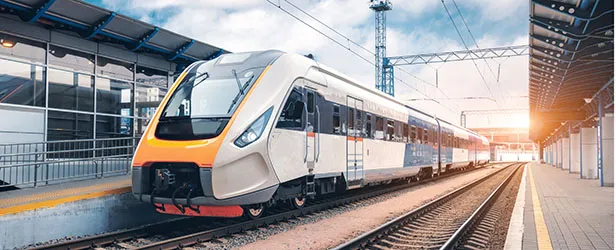Functional safety for rail industry
Functional safety ensures that the safety risks due to hazards caused by the malfunctional behavior of railway systems are managed to an acceptable level.
Effective management of safety risks in the railway industry is a critical issue for stakeholders. Rail hardware and software systems are complex and bound by architectures featuring layers of subsystems, products and interfaces. Rail components are sourced from multiple suppliers and development lifecycles are becoming shorter with increasing international competitive pressure.
Technical requirements
The EN 50126 is used for the specification and demonstration of Reliability, Availability, Maintainability and Safety for all railway applications. The standard describes the lifecycle process for railway systems. A systematic process for specifying requirements for RAMS and demonstrating that these requirements are achieved is defined.
The EN 50129 defines requirements for the acceptance and approval of safety-related electronic systems in the railway signalling field. For integrated design, implementation, commissioning, operation and maintenance safety-related systems, both hardware and software artefacts must be considered. Requirements for safety-related hardware and for the overall system are defined in this standard.
EN 50129 is concerned with the evidence to be presented for the acceptance of railway signalling electronic systems, including their safety functions and safety integrity level (SIL) thereof. It specifies those lifecycle activities which shall be completed before the acceptance stage, followed by additional safety engineering activities to be carried out afterwards, along with their formalisation in a safety case.
For safety-related systems which include programmable electronics, additional conditions for software are defined in EN 50128. This standard specifies procedures and technical requirements for the development of programmable electronic systems used in railway control and protection applications of any safety implications. The standard is intended to be used for software development, verification and validation, and the interaction between software and the system which it is part of.
Benefits
The right support provides any company with a starting point or a benchmark to develop robust solutions to ensure efficiency. The knowledge provided by DNV equips companies with a solid toolkit based on domain expertise and a risk-based approach, ensuring that safety critical applications attain consistent and measurable levels of safety throughout all lifecycle stages from design to operation & maintenance.
Related standards
The railway standards comprising of EN50126, EN50128 and EN50129 have been developed by CENELEC (European Committee for Electro-technical Standardization). These standards apply to both heavy rail systems (conventional, high speed, passenger and freight applications), light rail and urban mass transportation.
Technical railway standards concerning functional safety are:
- EN 50126 (IEC 62278) – Specification and demonstration of Reliability, Availability, Maintainability and Safety (RAMS);
- EN 50128 (IEC 62279) – Software for railway control and protection systems;
- EN 50129 (IEC 62425) – Safety related electronic systems for signalling.
Our offering
We provide services in the railway sector covering the following:
- Reliability Availability Maintainability and Safety (RAMS);
- Safety process compliant with EN 5012x;
- System integration, verification and validation;
- Software assurance;
- Independent assessment of selected safety critical systems;
- Quality, design and safety audits;
- Quantitative Risk Assessment (QRA);
- Hazard and Operability study (HAZOP);
- Failure Mode, Effect and Criticality Analysis (FMECA).

